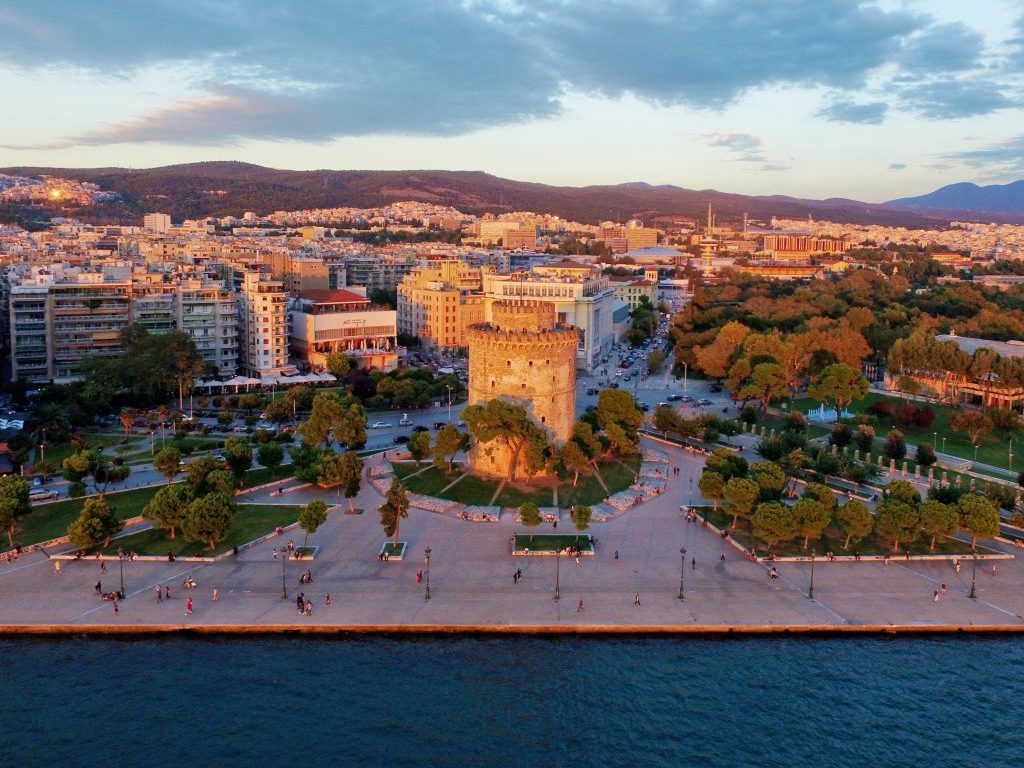The history of the city of Thessaloniki is a long one, dating back to the Ancient Greeks. Today with the opening of borders in Southeastern Europe it is currently experiencing a strong revival, serving as the prime port for the northern Greek regions of Macedonia and Thrace, as well as for the whole of Southeastern Europe.
The city was founded around 315 BC by King Cassander of Macedon, on or near the site of the ancient town of Therma and twenty-six other local villages. King Cassander of Macedon named the new city after his wife Thessalonike, a half-sister of Alexander the Great. She gained her name (“victory of Thessalians”) from her father, Philip II, to commemorate her birth on the day of his gaining a victory over the Phocians, who were defeated with the help of Thessalian horsemen, the best in Greece at that time. Thessaloniki developed rapidly and as early as the 2nd century BC, it had its first walls built, which enclosed and protected the city. The city also came to be an autonomous part of the Kingdom of Macedon, with its own parliament where a King was represented that could interfere in the city’s domestic affairs.
After the fall of the Kingdom of Macedon in 168 BC, Thessalonica as it came to be called in Latin, became a city of the Roman Republic. It grew to be an important trade-hub located on the Via Egnatia, the Roman road connecting Byzantium (later Constantinople) with Dyrrhachium (now Durrës in Albania), which facilitated trade between Europe and Asia. The city became the capital of one of the four Roman districts of Macedonia while it kept its privileges but was ruled by a praetor and had a Roman garrison. Also for a short time in the 1st century BC, Thessalonica even became capital for all the Greek provinces.
Thessaloniki’s acropolis, located in the northern hills, was built in 55 BC for security reasons, following Thracian raids in the city’s outskirts at the time.
In 306, Thessaloníki acquired a patron saint, St. Demetrius. He is credited with a number of miracles that saved the city and was the Roman Proconsul of Greece, under the anti-Christian emperor Maximian. St. Demetrius was martyred at a Roman prison, where the Church of St. Demetrius lies today. The church was first built by the Roman sub-prefect of Illyricum, Leontios, in 463. Other important remains from this period include the Arch and Tomb of Galerius, located in the city centre of the modern Thessaloniki.
In 390 Gothic troops under the commands of the Roman Emperor Theodosius I, led a massacre against the inhabitants of Thessalonica, who had risen in revolt against the Germanic soldiers.
When the Roman Prefecture of Illyricum was divided between the East and West Roman Empires in 379, Thessaloniki became the capital of the new Prefecture of Illyricum (reduced in size). Its importance was second only to Constantinople itself, while in 390 it was the location of a revolt against the emperor Theodosius I and his Gothic mercenaries.
Τhe city recovered and the gradual restoration of Byzantine power during the 10th, 11th, and 12th centuries brought peace to the area. During that time the city came to host the fair of Saint Demetrius every October, which was held just outside the city walls and lasted six days.
The economic expansion of the city continued throughout the 12th century as the rule of the Komnenoi emperors expanded Byzantine control into Serbia and Hungary, to the north. The city is known to have housed an imperial mint at this time. However, after the death of the emperor Manuel I Komnenos in 1180, the fortunes of the Byzantine Empire began to decline and in 1185, Norman rulers of Sicily, under the leadership of Count Baldwin and Riccardo d’Acerra, attacked and occupied the city, resulting in considerable destruction. Nonetheless, their rule lasted less than a year and they were defeated by the Byzantine army in two battles months later, forcing them to evacuate the city.
Thessaloniki passed out of Byzantine hands in 1204, when Constantinople was captured by the Fourth Crusade. Thessaloniki and its surrounding territory — the Kingdom of Thessalonica — became the largest fief of the Latin Empire, covering most of north and central Greece. The city was given by emperor Baldwin I to his rival Boniface of Montferrat, but was seized back once more in 1224 by Theodore Komnenos Doukas, the Greek ruler of Epirus, who established the Empire of Thessalonica. After the Battle of Klokotnitsa in 1230, Tsar Ivan Asen II of Bulgaria made the rulers of Thessaloniki his vassals. The city became subordinated to the Empire of Nicaea in 1242, when its ruler, John Komnenos Doukas, lost his imperial title, and was fully annexed in 1246.
At this time, despite intermittent invasion, Thessaloniki sustained a large population and flourishing commerce, resulting in intellectual and artistic endeavour that can be traced in the numerous churches and frescoes of the era and by the evidence of its scholars teaching there, such as Thomas Magististos, Demetrios Triklinios, Nikephoros Choumnos, Constantine Armenopoulos, and Neilos Kabasilas. Examples of Byzantine art survive in the city, particularly the mosaics in some of its historic churches, including in the basilica of Hagia Sophia and the church of St George.
The Byzantine Empire, unable to hold the city against the Ottoman Empire’s advance, handed it over in 1423 to the Republic of Venice. Venice held the city until it was captured after a three-day-long siege by the Ottoman Sultan Murad II, on 29 March 1430. The Ottomans had previously captured Thessaloniki in 1387, but lost it in the aftermath of their defeat in the Battle of Ankara against Tamerlane in 1402, when the weakened Ottomans were forced to hand back a number of territories to the Byzantines. During the Ottoman period, the city’s Muslim and Jewish population grew. By 1478, Thessaloniki had a population of 4,320 Muslims between 6,094 Greek Orthodox inhabitants. By c. 1500, the numbers of Muslims grew to 8,575 Muslims, with Greeks numbering at 7,986, making them a minority. Around the same time, Jews began arriving from Spain, fleeing persecution. In c. 1500, there were only 3,770 Jews, but by 1519, 15,715 Jews came to form 54% of the city’s population. The invitation of the Sephardic Jew’s expelled from Spain by Ferdinand and Isabella, was an Ottoman demographic strategy aiming to prevent the Greek population from dominating the city, as it had in previous years. Sephardic Jews, Muslims and Greek Orthodox remained the principal groups in the city for the next 400 years. The city came to become the largest Jewish city in the world and remained as such for at least 200 years. Of its 130,000 inhabitants at the start of the 20th century, around 60,000 were Sephardic Jews. Thessaloníki, became one of the most important cities in the Empire, viable as the foremost trade and commercial center in the Balkans. The railway reached the city in 1888 and new modern port facilities were built in 1896-1904. The founder of modern Turkey, Mustafa Kemal Atatürk, was born there in 1881, and the Young Turk movement was headquartered in the city in the early 20th century.
From 1870, driven by economic growth, the city’s population exploded by 70%, reaching 135,000 in 1917.
During the First Balkan War, the Ottoman garrison surrendered Salonika to the Greek Army, on 9 November [O.S. 27 October] 1912. This was a day after the feast of the city’s patron saint, Saint Demetrios, which has become the date customarily celebrated as the anniversary of the city’s liberation. After the Greek and Serbian victory in the Second Balkan War, which broke out among the former allies over the final territorial dispositions, the city’s status was finally settled by the Treaty of Bucharest on August 10, 1913, sealing the city as an integral part of Greece.
I n 1915, during World War I, a large Allied expeditionary force landed at Thessaloniki to use the city as the base for a massive offensive against pro-German Bulgaria. This precipitated the political conflict between the pro-Allied Prime Minister, Eleftherios Venizelos and the pro-neutral King Constantine. In 1916, pro-Venizelist army officers, with the support of the Allies, launched an uprising, which resulted in the establishment of a pro-Allied temporary government (the “Provisional Government of National Defence”), headed by Venizelos, that controlled northern Greece and the Aegean, against the official government of the King in Athens.
n 1915, during World War I, a large Allied expeditionary force landed at Thessaloniki to use the city as the base for a massive offensive against pro-German Bulgaria. This precipitated the political conflict between the pro-Allied Prime Minister, Eleftherios Venizelos and the pro-neutral King Constantine. In 1916, pro-Venizelist army officers, with the support of the Allies, launched an uprising, which resulted in the establishment of a pro-Allied temporary government (the “Provisional Government of National Defence”), headed by Venizelos, that controlled northern Greece and the Aegean, against the official government of the King in Athens.
On 18 August [O.S. 5 August] 1917, the city faced one of it most destructive events, where most of the city was destroyed by a single fire accidentally sparked by French soldiers in encampments in the city. The fire left some 72,000 homeless, many of them Jewish, of a population of approximately 271,157 at the time. Venizelos forbade the reconstruction of the town center until a full modern city plan was prepared. This was accomplished a few years later by French architect and archeologist Ernest Hebrard. The Hebrard plan, although never fully completed, swept away the oriental features of Thessaloníki and transformed it into the modern European metropolis that it is today. One effect of the great fire, came to be dubbed the Great Thessaloniki Fire of 1917, was that nearly half of the city’s Jewish homes and livelihoods were destroyed, leading to massive Jewish emigration. Their populations, however, were quickly replaced by considerable numbers of Greek refugees from Asia Minor as a result of the population exchange between Greece and Turkey, following the defeat of the Greek forces in Anatolia during the Greco-Turkish War. With the arrival of these new refugees, the city expanded enormously and haphazardly.
Thessaloniki fell to the forces of Nazi Germany on April 22, 1941 and remained under German occupation until 30 October 1944. The city suffered considerable damage from Allied bombing and almost all of its entire Jewish population that remained following the 1917 fire, was exterminated by the Nazis. Barely a thousand Jews survived. Thessaloniki was rebuilt and recovered fairly quickly after the war, with this resurgence taking in both a rapid growth in its population and a large-scale development of new infrastructure and industry throughout the 1950s, 1960s and 1970s. Most of the urban development of that period was however without an all-embracing plan, contributing to the traffic and zoning problems remaining to this day.
On 20 June 1978, the city was hit by a powerful earthquake, registering a moment magnitude of 6.5. The tremor caused considerable damage to several buildings and even to some of the city’s Byzantine monuments; forty people were crushed to death when an entire apartment block collapsed in the central Hippodromio district. Nonetheless, the large city recovered with considerable speed from the effects of the disaster. Early Christian and Byzantine monuments of Thessaloniki were inscribed on the UNESCO World Heritage list in 1988 and Thessaloniki later became European City of Culture in 1997.
Thessaloniki today has become one of the most important trade and business hubs in the Balkans with its port, the Port of Thessaloniki being one of the largest in the Aegean, and facilitating trade throughout the Balkan hinterland. The city also forms one of the largest student centres in Southeastern Europe and is host to the largest student population in Greece. The city sustains two state universities – the Aristotle University of Thessaloniki, the largest university in Greece (founded in 1926), and the University of Macedonia, alongside the Technological Education Institute of Thessaloniki. It also sponsors a range of private international institutions, either affiliated with universities in other nations, or accredited abroad.
In June 2003, the city was host to the Summit meeting of European leaders, at the end of the Greek Presidency of the EU, with the summit taking place at the Porto Carras resort in Chalkidiki, to aid security precautions. In 2004 the city hosted a number of the football events forming part of the 2004 Summer Olympic Games and experienced a massive modernisation program.



 Hellenistic era
Hellenistic era Byzantine era
Byzantine era Ottoman era
Ottoman era Modern era
Modern era